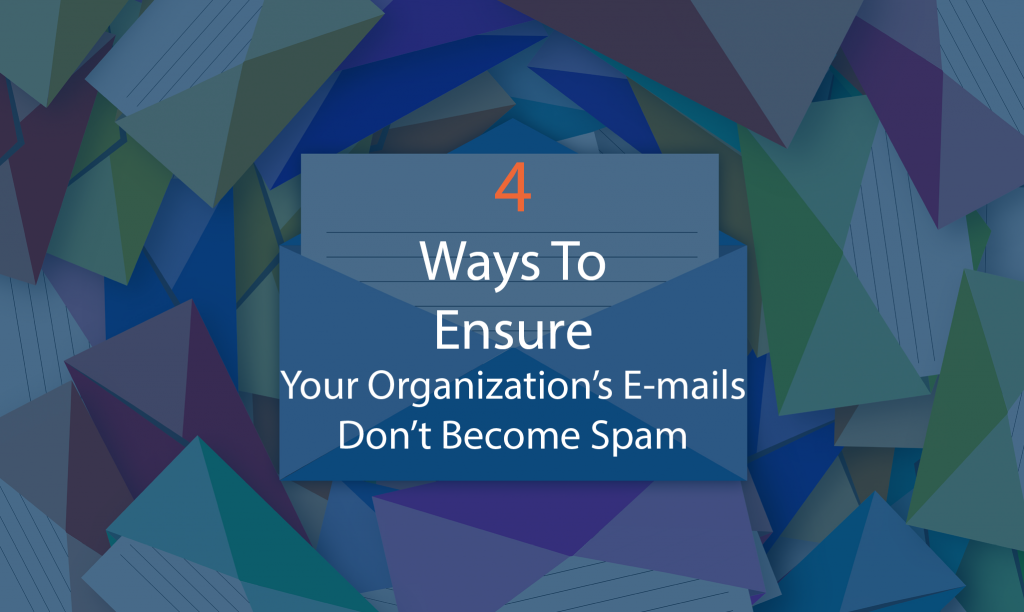The spam filter performs an excellent job preventing a flood of unsolicited messages hitting the inbox, but it also has a negative side — legitimate nonprofit’s email marketing often gets blocked.
An organization’s good reputation may also be damaged if too many of their emails get marked as spam. Mark Hrywna notes that in 2016 these filters cost American nonprofits an average of $25,000 in lost potential revenue.
There are many reasons why fundraising campaigns fail to live up to expectations.
Initial suspicions often fall on poor quality content, but spam filters block even some well-written emails. With a little forethought, you can improve your email open rates with ease. Make a start by giving some thought to the following four spam filter issues.

Understand how spam filters operate
A basic knowledge of how they work helps campaign organizers produce email marketing with high open rates.
Filtering systems examine the content of incoming emails for warning signs, and check for email addresses associated with being reported for spam. Typical negative elements include a spelling mistake in the “Subject” field, a title in capital letters and an unfamiliar address in the “From” field. Additionally, a long list of common spam words triggers filtering: “You have been selected,” “Member stuff” and “Opportunity” are a few typical examples. Comm100 supplies an extensive list of these problematic email expressions.
Fundraising email composers should be clear when they identify that the communication comes from their organization. Avoid spam trigger words, and check that the email contains no links to blocked sites. Poor HTML coding also increases the risk that emails end up in the spam box.
From where did you get that mailing list?
You want to ensure that your message reaches a wide audience. This might tempt you to invest in one of those lists of email addresses offered for sale or rent, but this ought to be avoided. These traded lists often contain large numbers of bad addresses. Furthermore, most legitimate email address owners resent unsolicited messages.
To expand your organization’s email marketing list encourage new contacts to enter their email addresses on your website. Include a checkbox so they can give explicit permission for you to send them newsletters or other promotional materials. Aim to only send emails to people who have clearly given their consent.
A little old-fashioned courtesy
Internet communications can be impersonal. Most email recipients still appreciate courtesy and consideration. Let them know how often they can expect to receive newsletters, invitations to special events and other types of mailings.
Each nonprofit needs to strike the right balance. On the one hand, they need to provide supporters informed of their activities on a regular basis. However, they must be careful not to annoy them with too many email marketing materials. Common courtesy also requires providing a link for opting out of the mailing list.
Another point to consider is what happens if an organization’s regular emails cease for a long period (for example, due to administrative issues) and then they are restarted — they might be blocked by the spam filter.
Change the look of fundraising emails
Fundraisers understandably include images of their activities in their emails but a high ratio of images to text leads to messages going to the spam folder. While pictures make messages more interesting, you can have too much of a good thing. Sometimes emails contain links to the website events page, new blog posts or affiliate organizations. If you keep down the number of these links it also reduces the chance of the email becoming spam. Remember, the more often recipients receive and open your emails the lower the risk that future emails get blocked.
Learn to be spam wise
- Stay clear of buying or renting email addresses.
- Let your subscribers know how frequently to expect emails from you.
- Put some thought into those simple content and design revisions that boost email open rates.
These strategies to improve deliverability are relatively easy to introduce. The potential benefits certainly justify the extra effort.
Other articles you may be interested in:
You May Also Like

Having a website is an absolute necessity for any business. Gone are the days when you could simply update your website once and forget about it for months on end. In today’s ever-changing digital landscape it is important to constantly track and measure how well your website performs, as well…
read more >
Thomas Bertram (T. Bert) Lance famously said, "If it ain't broke, don't fix it." Unfortunately, T. Bert Lance couldn’t foresee the future. He didn’t know that over 94% of Americans would be on the internet by 2024. If your website doesn't receive periodic updates or isn't accessible, users can become…
read more >



